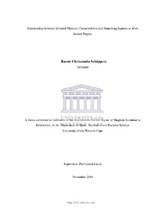| dc.description.abstract | Hamstrings muscle injury is the most frequent soccer-related injury in amateur and professional soccer players. Despite various interventions, the risk of hamstrings re-injury remains high. Several scientific studies examined the potential risk factors and their contribution to the occurrence of hamstrings injuries in male soccer players. The aim of the study was to investigate the relationship between selected physical characteristics, such as time-to-peak torque, hip abduction peak torque, hamstrings-to-quadriceps strength ratio, and hamstrings flexibility and the occurrence of hamstrings injuries in amateur male soccer players. A prospective, quantitative cross-sectional study design was utilized in this study. A total of 89 amateur male soccer players aged 18-35 years were recruited from the Cape Town Football District to perform functional assessments before injury occurred, which included anthropometric measurements, an evaluation of lower extremity isokinetic muscle strength (both knee and hip) and hamstrings flexibility tests. Instruments used to measure the anthropometric data were a calibrated Seca balance beam scale and stadiometer, a skinfold caliper, a sliding caliper, an anthropometer (All Harpenden, UK) and a metal tape measure. The Biodex Pro System 4 isokinetic dynamometer was used to measure lower extremity isokinetic muscle strength and a goniometer to measure hamstrings flexibility. Descriptive statistics included means and standard deviations, and inferential statistics included Pearson product-moment correlation to determine the relationship between selected physical characteristics and the occurrence of hamstrings injuries. Multivariate logistic regression via the forward stepwise method was utilised to predict potential physical characteristics (risk factors) for hamstrings injury in amateur male soccer players. Statistical significance was a p value of below 0.05. The prevalence of hamstrings injury was 4.3 %, with the multivariate logistic regression analysis indicating that time-to-peak torque was a significant predictor of the occurrence of hamstrings injury (OR = 1; p = 0.027). In conclusion, time-to-peak torque was a significant predictor of the occurrence of hamstrings injury. The players with hamstrings injuries produced a significantly slower time-to-peak torque, which has relevance for soccer players and coaches in addressing this common injury at all levels of competition. | en_US |

